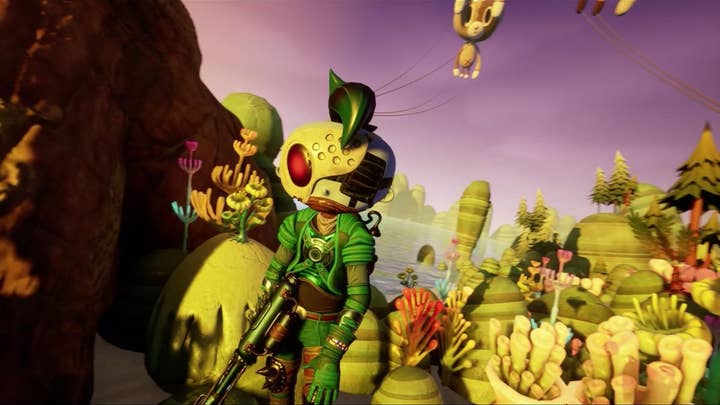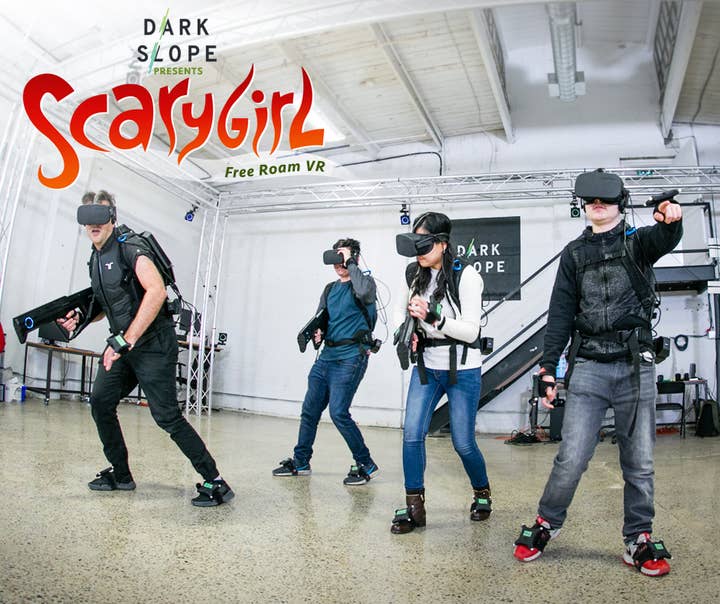Dark Slope thinking bigger with warehouse-scale VR
Co-founder CJ Hervey says location-based VR solves a lot of challenges, but adds in new ones
Virtual reality is something of a niche market at the moment. Location-based VR is something of a niche within that niche, but it's one that Dark Slope sees great potential in. The Toronto-based developer has committed itself to location-based VR, and even though it's a small field at the moment, Dark Slope president and co-founder CJ Hervey tells GamesIndustry.biz it has enormous potential for VR in general.
"The experience is just so, so different," Hervey says. "It's by far the most exciting experience that any of us have had in virtual reality, so we wanted to work there and create those experiences for other people."
Consumer-level VR headsets like the Vive typically offer room-scale experiences, and existing VR arcades are merely ways for people to try those same experiences without needing to own the hardware. However, Dark Slope is designing experiences for "warehouse-scale" VR, facilities with a 2,000-square-foot play area underneath a motion-tracking camera system that follows up to eight players in real space and accurately positions them within each other's worlds. It has already launched the eight-player action game Scarygirl Mission Maybee in Toronto, and has struck a deal to have the game launched this summer throughout the chain Zero Latency, which boasts 29 warehouse-scale VR locations in 18 countries.

"My personal belief is [location-based VR] is really just beginning," Hervey says. "There was a bit of a shake-out of the first wave of VR that was just a consumer home experience in a public space. This next wave of stuff we're making is really a production value you could only have at a destination. We're using full-body tracking to create a full representation of people in space and allowing them to move untethered on a 1:1 ratio through an experience. It's really creating something that is entirely new. When people do it, they say, 'This is what people told me virtual reality was going to be.' It's a physical participation within the experience that is so different from anything you could do at home."
"We found ourselves here because this is the area where you can solve a lot of the challenges of VR"
One benefit for doing warehouse-scale VR like this is that it lessens or even eliminates some of the problems facing developers of room-scale experiences.
"We found ourselves here because this is the area where you can solve a lot of the challenges of VR," Hervey says. "It's a high production value experience for a low cost of entry. You don't have to buy a system to experience it; you just have to buy a ticket. And then the 1:1 ratio of being positioned in the space and moving around with the same locomotion you would in the real world eliminates any kind of nausea."
That said, it creates a number of new problems to solve as well.
"It's less reinventing the wheel than it is trying to invent the wheel, which is exciting," Hervey says. "In this world, movement exists because you're physically moving and we're tracking you in the space. But that leads to a challenge, which is how you motivate an audience to move through the space and what kind of experience do you create for them geographically without always relying on the same tricks."
There's also the issue of what players are expecting from warehouse-scale VR. Hervey suggests there are two broad genres in VR -- games with a weapon and games without a weapon -- but the location-based VR scene hasn't evolved to the point where the action shooters of the world stand completely apart from more exploratory puzzle games.
"Some people really want an experience where they have a lot of space, room to explore and time to look at the world they're in because they're enamored with the idea of being in a virtual world," Hervey says. "Other people are just looking for the gameplay action of it, so you have to strike an interesting balance between gameplay and exploration."
Scarygirl walks that line between the genres, but because it is based on Nathan Jurevicius' existing graphic novel and designer toy brand, Dark Slope wanted to be sure that the game not only reflected Jurevicius' creative vision, but allowed them to soak in the world a little bit more than they would have in a more straight-forward action game.

Warehouse-scale VR also introduces additional logistical considerations.
"You have to think about how an experience works for an operator," Hervey says. "How easy is it to get people in and out of it? How quickly can people understand what you're asking them to do in the VR activity? And there are also a lot of gaming conventions that come into that. Because that's the ultimate promise, that you're putting people inside the game and they have the ability to play the game on the ground level. You have to bring those gaming conventions to satisfy that audience as well."
But Dark Slope's biggest challenge as a studio is one it has little direct control over. Simply put, no matter how good the games it makes are, there aren't a lot of places to play them right now.
"We want to see more places to exhibit our content grow faster, and to see people get more and more locations," Hervey says. "We're working with chains who are growing rapidly, but they're still numbered in the tens of locations versus the hundreds of locations. That's the next thing."
Hervey says that growth has been hurt by the sheer expense of opening such venues, but that cost is coming down as the technology and tracking systems evolve.
Hervey is also well aware that warehouse-scale venues and warehouse-scale content developers are utterly reliant on each other to grow the market, so Dark Slope is trying to do what it can to make the operators' business more viable. For example, it can be prohibitively expensive for some operators to have a building with a play area of 2,000-square foot in certain places, so Dark Slope is working on a version of Scarygirl that would require about half the space (making for a space roughly 30 feet by 30 feet).
"It takes a critical mass of people doing these experiences, and I think that's just starting to happen."
